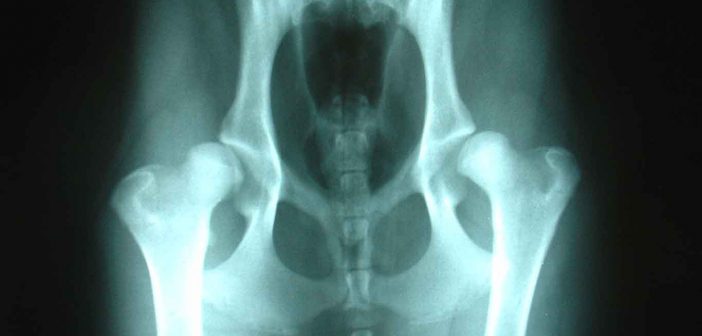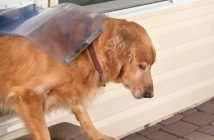Canine Hip Dysplasia (CHD) is a congenital disease that mainly affects large breed dogs. The word “dysplasia” means improper growth. Hip dysplasia can be described as a faulty or abnormal development of the hip. In CHD, the hip becomes loose and wobbly, eventually leading to a form of arthritis which is commonly referred to Degenerative Joint Disease (DJD). The degree of lameness that occurs is usually dependent upon the extent of arthritic changes in the hip joint. So too do environmental conditions such as amount of physical exercise, and weight gain contribute to the disease, and bring out symptoms.
What Are the Symptoms of Canine Hip Dysplasia?
The symptoms of CHD depend on the severity of the dysplasia. Another factor is the whether or not degenerative joint disease (DJD) is present. Dogs less than 1 year old have a tendency to have periods of acute bilateral (or unilateral) lameness in their rear legs. Older dogs with CHD exhibit rear limb lameness with an obvious weight displacement to the forelimb (front paws). Furthermore, the signs of lameness become more obvious with exercise or after a minor trauma. Again depending on the degree of joint destruction, visible signs vary. Typical signs are:
- Generally less active.
- Problem with stairs.
- Less jumping
- Trouble rising, or laying down.
- When running will exhibit a ABunny hopping@ gait
- Painful reaction to the extension of the rear legs.
- A faint popping sound coming from the hip.
Are All Dogs at Risk Canine Hip dysplasia?
CHD can occur in any dog. However, large breed dogs are at a higher risk. The Orthopedic Foundation of Animals (OFA) believes that some of the breeds at highest risk are:
- Bulldog
- Pug
- Otterhund
- Clumber Spaniel
- Neapolitan Mastiff
- St. Bernard
- Boykin Spaniel
- Sussex Spaniel
- American Bulldog
- Newfoundland
- American Staffordshire Terrier
- Bloodhound
- Bullmastiff
- Chesapeake Bay Retriever
- Golden Retriever
- Gordon Setter
- Rottweiler
- Chow Chow
- Old English Sheepdog
- Kuvasz
- Norweigan Elkhound
- Giant Schnauzer
- German Shepherd
- Bernese Mountain Dog
- English Setter
- Black and Tan Coonhound
- Shih Tzu
- Staffordshire Terrier
- Welsh Corgi
- Beagle
- Briard
- Brittany
- Bouvier des flandres
- Welsh Springer Spaniel
- Curly Coated Retriever
- Polish Lowland Sheepdog
- Portugese Water Dog
- English Springer Spaniel
- Pudel Pointer
- Irish Water Spaniel
How is Canine Hip Dysplasia Diagnosed?
Initial assessment involves taking a history of the dog, and examining obvious clinical signs. The only real way to see if a dog is suffering from CHD is through X Rays. If found early enough in pups, surgery can correct the problem.
What Is the Treatment of Canine Hip Dysplasia?
Treatment for CHD can be as mild as recommending rest, or as severe as surgery, depending on the severity of the dysplasia, amount of DJD, the age of the dog, the size of the dog, and many other factors, treatment will vary. Possible Conservative Treatment:
- Weight monitoring
- Moderate exercise
- Pain relief medication
- Joint and health supplements
- Possible Surgical Treatment
Currently there are three main surgical procedures used in for the treatment of CHD.
- Triple Pelvic Osteotomy (TPO)
In this procedure, three separate bone cuts are made in order to free the acetabulum component (the socket or cup) of the hip joint from the rest of the pelvis. The acetabulum is then rotated to provide better coverage. A bone plate is secured to maintain this new position and allow the bone cuts to mend. The procedure is for large breed dogs, no older than 10 months of age. Candidates for this surgery must only have mild CHD and no arthritis present. - Femoral Head Ostectomy (FHO)
In this procedure, the head of the femur is removed. The residual portion of the femur forms a ?false” joint with muscle, tendons and ligaments. Even though the false joint is not as superior as the original, most dogs experience a great reduction in pain. This particular surgery is far more effect in smaller dogs, with most experiencing an almost normal function of the hip. - Total hip replacement (THR)
In this procedure the head and neck of the femur are both replaced with either stainless steel or titanium implants. This surgery is used on young dogs who have fully matured developed physically. THR is also used in older dogs who weigh a minimum 40lbs. If done correctly, the procedure can be very successful; however it is only done by a select few, and is very expensive.
Is There Any Way to Prevent Canine Dysplasia?
CHD is a combination of genetics and environmental factors. Responsible breeders are working on reducing the chances of CHD by breeding dogs that are less likely to produce pups that will have the disease, by better sceening methods.
Environmental factors do NOT cause CHD. Instead, they bring out the symptoms in a dog that already has the disease. Responsible owners can help dogs with CHD by addressing these environmental variables. By closely monitoring a dog?s diet, for example, owners can insure that a pup will not grow too fast, or become over weight. Here is a list of variables that can be controlled in order to nurture a dog with CHD.
- Limit rough play, jumping, climbing stairs or slick floors.
- Monitor food intake.
- Calcium supplementation (may increase the bone remodeling).
- Forced running for any distance, especially on tarmac, asphalt or other hard surfaces
- Have your dog certified by The Orthopedic Foundation for Animals (OFA)
Hip dysplasia is an all too common condition that occurs more frequently in large dog breeds, but can also occur in smaller breeds. A “close” stance of the hind legs and any noticeable difference in the way your dog’s behaving in the hind quarters is definitely worth checking out at the vet. If left untreated it can be painful and crippling.
Featured Xray Image:
Joelmills [CC BY-SA 2.5, GFDL or CC-BY-SA-3.0], via Wikimedia Commons




